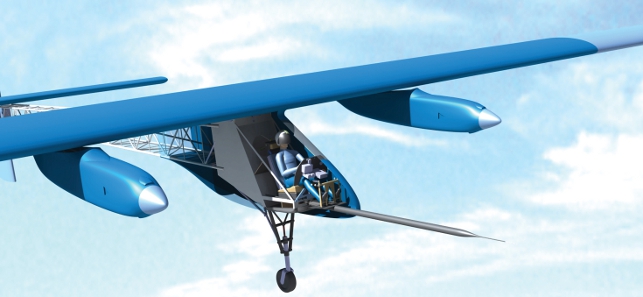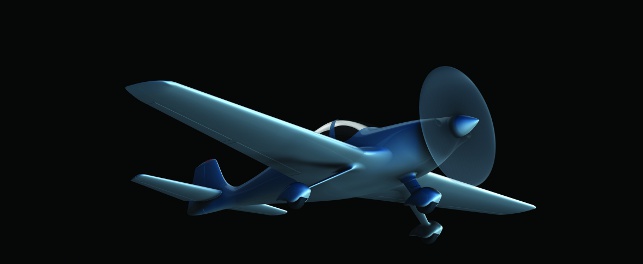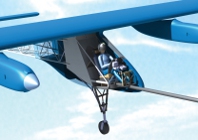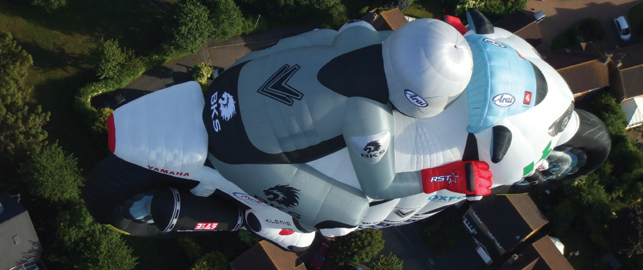
A motorcycle balloon, for George White motorcycle sales group
Full of hot air
Graceful, colourful, and occasionally down-right strange, hot air balloons come in all sorts of designs.
Andy Marshall, design engineer at Shropshire-based Lindstrand Hot Air Balloons, has been responsible for some of the most eyecatching, ranging from your more common teardrop shapes to dogs, dragons and, er, rolled up newspapers.
The majority of the “special shapes” as they are delicately described, are marketing devices. For George White, a motorcycle Stephen Holmes has his head in the clouds as he discovers what’s in the air sales group, you couldn’t get more eyecatching than a giant bike and rider popping a wheelie several hundred feet up in the air.
Initial ideas and sketches from the client are transformed into an AutoCAD wireframe that quickly gives the overall shape of the balloon. The Lifting Volume (LV) is the key component carrying the structural load of the basket, deflation system and the surface through which air is distributed to inflate the appendages.
It is then masked by first tier appendages – in this design the rider, fairing and bike swing arm – these in turn lead into second tier and third tier appendages. Each panel is drawn in 3D, before being mapped in AutoCAD into a 2D component. These are separated into batches of coloured components and given a unique part code and number.
The result is miles of panel profiles, over 5,500 in this case, manipulated to fit 1.5m wide roles of fabric. Appliquéd artwork is cut and pinned to panels before being sewn into position panel by panel.
To keep the shape of the balloon, structural assembly requires intricate ‘formers’ to be built into the design, constructed and sewn to the internal surface. Flat structures require the most to counteract ‘bulges’ that air pressure brings.
The seat and tyres of the bike have highly complex inner structures, while naturally curving shapes like the rider’s body, and helmet require very little as the shape naturally lends itself to the task.
Cold inflation tests are used, first on parts of the balloon to assess the large structures, before a full inflation is used for rigging installation, checking of artwork, and any troubleshooting.
Finally all that is left is to hop in the basket and take to the skies.
Sunny skies
The team from Solar Impulse has designed an aircraft powered solely by solar energy, able to fly during the day and at night.

The HBSIA
The project is promoted by Bertrand Piccard, the man who co-piloted the first balloon to circle the world non-stop. The Swiss-based team is hoping that following on from this initial prototype – the HBSIA
– its next craft will similarly be able to circumnavigate the globe in under 25 days.
The design is a single-seat craft with a wingspan of 63.4 metres, made as light as possible using a custom carbon fibre honeycomb sandwich. To the massive wings, four 10hp motors are attached that draw their power from a set of lithium polymer batteries.
11,628 photovoltaic cells on the upper wing surface and the horizontal stabiliser generate electricity throughout the day, both propelling the plane and charging the batteries to allow flight at night. This theoretically allows the plane to stay in the air indefinitely, with a top speed of 70Kph.
The project was designed in 3D using CATIA to create a complete 3D digital model of the aircraft. This included the position of the cockpit and the ergonomics for the pilot; and to help optimise the aerodynamics of the craft.
Everything down to the smallest bolts was managed using Enovia SmarTeam to help direct the project and the vast amounts of parts needed.
Flight of the phoenix
Although Britain’s long history of pioneering aircraft has faded in recent decades, Swift Aircraft is looking to resurrect British aviation with cutting-edge technology.

The Swift range
Its goal is to develop a series of composite aerobatic training aircraft that can be used by flight training schools, the military as well as the general aviation market.
“The Swift range of aircraft has been designed using an advanced suite of aerodynamics calculations that create a framework onto which the aircraft styling can be overlaid,” says Swift’s design manager Sam Dickinson. “There is little point in designing a beautiful aircraft if it won’t fly!”
This software-based solution outputs a large number of key design criteria that is fed into Pro/Engineer as a Pro/Program driven skeleton model. The skeleton models are then added to, with elements of styling and mechanical geometry to “flesh out” the design.
Once the primary aerodynamic shapes have been developed they are exported into ANSYS/Fluent for CFD analysis, while the mechanical design continues concurrently.
Although not yet at the stages of manufacture, the 3D models have already proved useful as a means of marketing the aircraft, using renders to show off the aerodynamics and styling.
We take to the skies!
Default






